
Forex Magnates checked in with Anthony DiSanti, Chief Marketing Officer at Shift Forex, during a stateside visit to discuss the group’s regional diversification and FX prospects in Latin America.
Mr. DiSanti has already ascended to the FX elite, having entered into the forex realm as recently as 2007 as the Vice President of Marketing Analytics at FXCM. In addition, he has also worked as the Director of Business Intelligence at Chloe + Isabel Inc., before becoming a Founding Partner at Shift Analytics in 2013. His full-length interview can be read below.
1) What type of client requests are you guys receiving?
We work with a wide range of clients these days. When we first started, we were focused strictly on the retail side on the market because that’s where our experience was. My background specifically is from FXCM, having built their marketing analytics infrastructure. More recently, we have been involved in larger scale engagements with some larger brokers in the United States.
As our brand has grown and we have gained more experience in the industry, our target clients have evolved. Of course you have the retail brokers, everyone from the smaller brokers that we help launch to the largest brokers around. But now we also work with many of the vendors that sell into the market, including the startups that present at our ‘Innovators Inquisition’ during FXIC like CurrentDesk.
We also work with a couple education vendors but our largest growth is coming from the institutional side of the market and helping large companies enter the FX space. NASDAQ is one of the biggest clients we’ve worked with recently – we helped them increase volumes in their FX options offering, capturing more of the FX market. In addition, many hedge funds are interested in FX market-making, so we have helped to develop a product offering and distribute that Liquidity throughout the market.
Historically, we focused on project-based engagements, helping our clients achieve specific goals. As our network has expanded, we’ve seen many opportunities to connect people on all sides of the industry, culminating in our M&A business. On the marketing side, the most exciting opportunities are around FX market entry, though we continue to work with a variety of FX participants, managing their media or focusing on specific projects – analytics implementations, platform launches, regional expansion, etc.
2.) What is your interest in the US, or other regional markets?
The US market is always a focus, but the retail market here is highly consolidated so there are limited targets for consulting companies. We’re still excited about the US and there are some large players looking at the space. Phillip Futures just got their FDM approved, the first in the past seven years or so. We’ve done business with all the major brokers, and right now we're very excited about emerging players, particularly in the institutional space.
Ultimately with the growth coming out of Southeast Asia and abroad, that’s where most of our clients are focused these days. We are helping some established brokers target Southeast Asia and Latin America – we see those as two really lucrative opportunities, emerging markets in the FX space that can drive dramatic growth.
Last year, we expanded our FXIC event series to Santiago, Chile. Despite the country’s relatively young age, they have become one of the most established financial centers in the region. We see a significant opportunity for international brokers to develop the Latin American market, rather than simply targeting specific countries that have begun emerging. The retail FX market there is relatively consolidated via money managers and fund managers that are looking to get FX exposure and effectively incorporate FX into their strategies without the counterparty risk of working with local players lacking the sophisticated monetary controls commonly found in the EU, US and Australia.
Those international brokers targeting Latin America need to be aware of local banking regulations that make it difficult to get money out of the country. It’s not so much about which countries to target, but rather which countries to avoid targeting. In countries like Argentina and Venezuela, you are going to have trouble transferring funds out, whereas Chile has much more progressive financial legislation.

The FX market in general is tiered, and this extends into the retail market. A broker’s business model will determine which types of clients they target. A high cost model built around premium support and tools will require larger account balances, so there will be client segments that simply aren’t profitable to target. The Latin American market currently tends to have 3 client segments – money managers, high net worth, and low balance/high maintenance clients. If you’re targeting the mass-market retail trader there, you need to have a model that supports low balances with significant customer support requirements. In my opinion, there are only two countries in the region with large enough retail FX markets to justify dedicated targeting from international brokers, Chile and Mexico. However, this is changing every day – if you compare today’s market to just last year, there’s been material growth.
Speaking about the growth in Southeast Asia, I am referring to Malaysia, India, China, etc. When you’re targeting that region, the traders tend to be less sophisticated – EA traders, people that are strongly attracted to promotions, etc. Promotions are very successful in these markets, so if you have the regulatory structure and business model where you can offer high leverage and aggressive promotions, SEA should be a high priority.
We see a lot of offshore brokers growing rapidly by running frequent promotions and marketing them aggressively. Local partnerships are also very important, as business still tends to happen face-to-face, sometimes with deposits being physically handed to IBs. The market fragmentation in this region leads to very different IB structures than many brokers may be used to from their business elsewhere. Working with someone that knows the region well is critical to successful expansion into SEA.






















